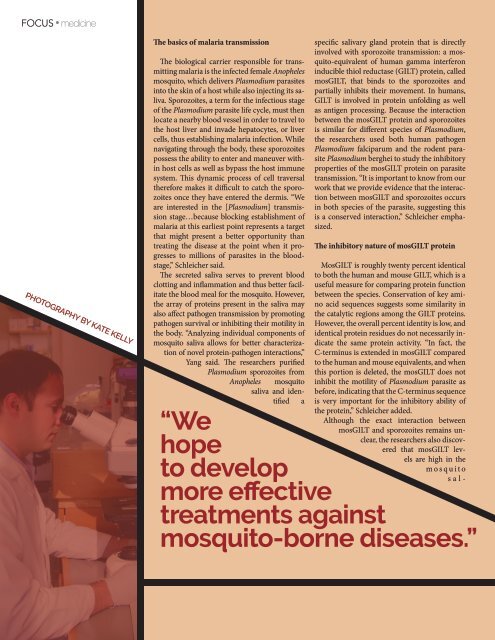YSM Issue 91.3
Create successful ePaper yourself
Turn your PDF publications into a flip-book with our unique Google optimized e-Paper software.
FOCUS<br />
medicine<br />
PHOTOGRAPHY BY KATE KELLY<br />
The basics of malaria transmission<br />
The biological carrier responsible for transmitting<br />
malaria is the infected female Anopheles<br />
mosquito, which delivers Plasmodium parasites<br />
into the skin of a host while also injecting its saliva.<br />
Sporozoites, a term for the infectious stage<br />
of the Plasmodium parasite life cycle, must then<br />
locate a nearby blood vessel in order to travel to<br />
the host liver and invade hepatocytes, or liver<br />
cells, thus establishing malaria infection. While<br />
navigating through the body, these sporozoites<br />
possess the ability to enter and maneuver within<br />
host cells as well as bypass the host immune<br />
system. This dynamic process of cell traversal<br />
therefore makes it difficult to catch the sporozoites<br />
once they have entered the dermis. “We<br />
are interested in the [Plasmodium] transmission<br />
stage…because blocking establishment of<br />
malaria at this earliest point represents a target<br />
that might present a better opportunity than<br />
treating the disease at the point when it progresses<br />
to millions of parasites in the bloodstage,”<br />
Schleicher said.<br />
The secreted saliva serves to prevent blood<br />
clotting and inflammation and thus better facilitate<br />
the blood meal for the mosquito. However,<br />
the array of proteins present in the saliva may<br />
also affect pathogen transmission by promoting<br />
pathogen survival or inhibiting their motility in<br />
the body. “Analyzing individual components of<br />
mosquito saliva allows for better characterization<br />
of novel protein-pathogen interactions,”<br />
Yang said. The researchers purified<br />
Plasmodium sporozoites from<br />
Anopheles<br />
mosquito<br />
saliva and identified<br />
a<br />
specific salivary gland protein that is directly<br />
involved with sporozoite transmission: a mosquito-equivalent<br />
of human gamma interferon<br />
inducible thiol reductase (GILT) protein, called<br />
mosGILT, that binds to the sporozoites and<br />
partially inhibits their movement. In humans,<br />
GILT is involved in protein unfolding as well<br />
as antigen processing. Because the interaction<br />
between the mosGILT protein and sporozoites<br />
is similar for different species of Plasmodium,<br />
the researchers used both human pathogen<br />
Plasmodium falciparum and the rodent parasite<br />
Plasmodium berghei to study the inhibitory<br />
properties of the mosGILT protein on parasite<br />
transmission. “It is important to know from our<br />
work that we provide evidence that the interaction<br />
between mosGILT and sporozoites occurs<br />
in both species of the parasite, suggesting this<br />
is a conserved interaction,” Schleicher emphasized.<br />
The inhibitory nature of mosGILT protein<br />
MosGILT is roughly twenty percent identical<br />
to both the human and mouse GILT, which is a<br />
useful measure for comparing protein function<br />
between the species. Conservation of key amino<br />
acid sequences suggests some similarity in<br />
the catalytic regions among the GILT proteins.<br />
However, the overall percent identity is low, and<br />
identical protein residues do not necessarily indicate<br />
the same protein activity. “In fact, the<br />
C-terminus is extended in mosGILT compared<br />
to the human and mouse equivalents, and when<br />
this portion is deleted, the mosGILT does not<br />
inhibit the motility of Plasmodium parasite as<br />
before, indicating that the C-terminus sequence<br />
is very important for the inhibitory ability of<br />
the protein,” Schleicher added.<br />
Although the exact interaction between<br />
mosGILT and sporozoites remains unclear,<br />
the researchers also discovered<br />
that mosGILT levels<br />
are high in the<br />
mosquito<br />
sal-<br />
“We<br />
hope<br />
to develop<br />
more effective<br />
treatments against<br />
mosquito-borne diseases.”


















